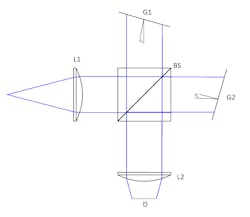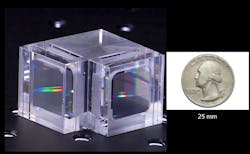John Harlander and Fred Roesler of the University of Wisconsin (Madison, WI) presented the first spatially heterodyne spectrometer (SHS) during the July 1990 Astronomical Telescopes and Instrumentation conference put on by SPIE, the international society for optics and photonics (Bellingham, WA). They introduced the instrument as an alternative to conventional spectrometers for astronomical observations.1 Revolutionary at the time, the SHS optical design offered an increased etendue and a more compact size compared to other spectrometers. Unbeknownst to the astronomical community, however, Michael Morris and the other founders of Ocean Optics (Dunedin, FL), at approximately the same time developed the first commercial miniature spectrometer: the S1000. After its 1992 release, miniature spectrometers quickly dominated the spectroscopy marketplace and overshadowed SHS for the next two decades.
Perceived difficulties surrounding the interferometer’s two grating precision alignment prevented SHS technology from initially gaining widespread market acceptance. Since SHS’ introduction, miniature spectrometers have taken many forms—ranging from simple filter-based instruments to complex microelectromechanical-systems (MEMS)-based Fourier transform infrared (FTIR) devices.2 Progressively smaller spectrometers have entered the market since the turn of the century, and they have fueled advancements in a wide range of industries. Some applications, such as the widespread deployment of handheld Raman analyzers in the pharmaceuticals sector, have become easily recognizable to the general public. Other advancements, though less familiar to the public, are noteworthy as well. One such example is the LED lighting industry’s rapid deployment of portable spectroradiometers to meet its ever-growing needs. Miniature spectrometers have even proven their value beyond this planet, having reached the surface of Mars with the Curiosity rover in 2012.
Fortunately, SHS design has adopted several advancements over the past decade. The improvements have culminated in a fully monolithic design3 that could lead to a SHS renaissance—especially for portable Raman and laser-induced breakdown spectroscopy (LIBS) analyzers.4 Though initially developed for space and other rugged environments, monolithic SHS (mSHS) could revolutionize point-of-care medical screening. To fully understand the potential impact of these developments, one must take the time to understand the details of SHS novel optical design compared to traditional miniature spectrometers used today for point-of-care medical screening diagnostics.
SHS optical design
At the most fundamental level, a SHS is a Michelson interferometer whose mirrors have been replaced with diffraction gratings. Figure 1 shows a schematic diagram of the typical SHS, where the light collected from the sample is collimated (L1) and directed through a 50/50 beamsplitter (BS). Each beam is directed to diffraction gratings (G1 and G2), angled to ensure the Littrow angle parallels the optical axis. After reflection, the BS recombines both beams and a detector array (D) displays their image (L2).
Suppose the incoming light equals the Littrow wavelength. In this case, the wavefront will experience no phase shift, but at all other wavelengths will end up with a wavefront tilt that creates interference fringes at the detector plane. Therefore, upon Fourier transform, the zero spatial-frequency component will correspond to the Littrow wavelength and all other wavelengths will result in either positive (>λL) or negative (<λL) spatial frequency shifts.
Unlike in traditional dispersive spectrometers, whose spectral range and resolution depend on the entrance slit and distance from the diffraction grating to the detector, the range and resolution of a SHS rely solely on the number of grooves illuminated on the diffraction grating and the number of detector pixels. SHS is fundamentally insensitive to overall size, making it an ideal candidate for ultracompact spectral sensors in portable Raman LIBS instrumentation.
Breakthroughs in SHS design
In a 2011 collaboration, S. Michael Angel’s group at the University of South Carolina (Columbia, SC) and J. Chance Charter at the Lawrence Livermore National Laboratory (Livermore, CA) successfully demonstrated the first spatially heterodyne Raman spectrometer (SHRS).5 The initial proof-of-concept study inspired the Angel group to embark on a nearly decade-long research program, culminating in Abigail Waldron’s announcement of the first-ever monolithic SHRS (mSHRS) at the 2020 Lunar and Planetary Science Conference (held virtually).3 Figure 2 shows the mSHRS, which eliminates the need to actively align the diffraction gratings by using two custom N-BK7 spacers. The spacers’ design maintains the gratings at the exact Littrow angle, with an accuracy of one-thousandth of a degree.6 The configuration results in a lightweight (~80 g) compact footprint (roughly 3.5 × 3.5 × 2.5 cm), a mSHRS range of approximately 3500 cm-1, and a spectra resolution of 4–5 cm-1 with a 600 grooves/mm grating blazed at 500 nm.When asked to comment on his primary motivation for developing the mSHRS, Angel stated the “monolithic construction allows for an interferometer-based spectrometer that is calibration-free and not affected by vibrations.” He later added, “there are important aspects of the spatial heterodyne interferometer approach to Raman spectroscopy that we have only just started to explore, such as one-shot hyperspectral Raman imaging,7 and the use of diffuse excitation sources (defocused lasers or maybe even LEDs).” When asked for his thoughts on biomedical applications, Angel—after cautioning that he is not an expert in the area—said, “any biomedical application that could benefit from a small, rugged, calibration-free Raman spectrometer, that can use a diffuse excitation source, represents a potential market.”
Looking toward the future
Over the next several years, countless unforeseen applications will benefit from using mSHS as the optical throughput advantages of mSHS and the inherent insensitivity of the spectral range and resolution on physical size become more widely understood. Angel expressed his eagerness to collaborate with others seeking to take advantage of the breakthroughs. “I look forward to working with anyone who would like to develop it further,” he said.
Although the custom spectrometers described in this article remain relatively costly, Angel anticipates that prices will rapidly decrease as production volumes scale up. It appears that mSHS could outperform comparably sized miniature spectrometers at the same or lower cost. Still in its infancy, the technology holds the potential for deployable field applications ranging from underwater sensing to mobile medical screening and diagnostics.
REFERENCES
1. J. M. Harlander and F. L. Roesler, Proc. SPIE, 1235, 622–633 (Jul. 1990).
2. Z. Yang, T. Albrow-Owen, W. Cai, and T. Hasan, Science, 371, 6528 (2021).
3. A. Waldron et al., Proc. LPSC, paper 1137 (Mar. 16–20, 2020).
4. A. Waldron, A. Colón, J. C. Carter, S. Sharma, and S. M. Angel, Proc. LPSC, paper 1196 (Mar. 15–19, 2021).
5. N. R. Gomer et al., Appl. Spectrosc., 65, 8, 848–857 (2011).
6. A. Waldron, A. Allen, A. Colón, J. C. Carter, and S. M. Angel, Appl. Spectrosc. (2020); doi.org/10.1177/0003702820936643.
7. A. N. Allen, A. M. Waldron, J. M. Ottaway, J. C. Chance, and S. M. Angel, Appl. Spectrosc., 74, 8, 921–931 (2020).
About the Author
Robert V. Chimenti
Director, RVC Photonics LLC
Robert V. Chimenti is the Director of RVC Photonics LLC (Pitman, NJ), as well as a Visiting Assistant Professor in the Department of Physics and Astronomy at Rowan University (Glassboro, NJ). He has earned undergraduate degrees in physics, photonics, and business administration, as well as an M.S. in Electro-Optics from the University of Dayton. Over a nearly 20-year career in optics and photonics, he has primarily focused on the development of new laser and spectroscopy applications, with a heavy emphasis on vibrational spectroscopy. He is also very heavily involved in the Federation of Analytical Chemistry and Spectroscopy Societies (FACSS), where he has served for several years as the Workshops Chair for the annual SciX conference and will be taking over as General Chair for the 2021 SciX conference.


